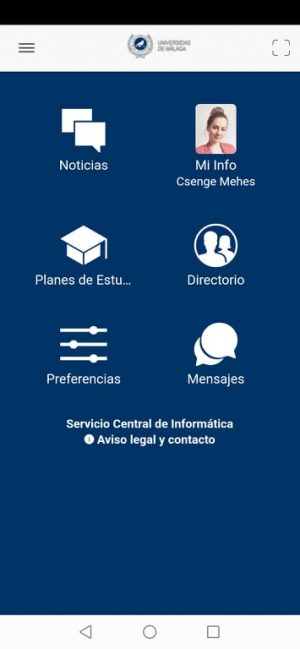Differences between Hungarian and Spanish Universities
As I was spending my Erasmus in Málaga last semester, I experienced every day the similarities and differences of the educational system in Spain and in Hungary. Obviously, I don’t have the sufficient experience to talk about each and every university in Spain, since they might differ in some cases, but I would like to highlight some core factors, which are contrasting in case of the Universidad de Málaga (UMA), and the University of Pannonia (PE).
 First of all, when we start our education at a university in Hungary, we receive a 6-letter code, made up with letters and numbers, which will identify us for the rest of our studies, and makes it easier to keep everything anonymous for the sake of personal data protection. Similarly, at UMA we are assigned a personal identification code, which is a sequence of ten numbers. We use this to activate and log in to our Campus Virtual account, which is the equivalent of the Hungarian Moodle system. Here we can register to our courses of the semester, and we are informed about the syllabus and requirements of these courses. This platform’s functions also include the direct access to the course material slides, and the possibility to write midterm exams, which will be later evaluated. Nonetheless, UMA also has an internal webmail system, with the help of which students can send and receive e-mails about university matters. This helps the fluent and smooth communication between the professors and students. On the other hand, if students want to book a seat and spend time with studying in the libraries of the different faculties, the confirmation e-mail is also coming in to this address. In this case we receive a QR code, which we have to show the librarians before we take our seats.
First of all, when we start our education at a university in Hungary, we receive a 6-letter code, made up with letters and numbers, which will identify us for the rest of our studies, and makes it easier to keep everything anonymous for the sake of personal data protection. Similarly, at UMA we are assigned a personal identification code, which is a sequence of ten numbers. We use this to activate and log in to our Campus Virtual account, which is the equivalent of the Hungarian Moodle system. Here we can register to our courses of the semester, and we are informed about the syllabus and requirements of these courses. This platform’s functions also include the direct access to the course material slides, and the possibility to write midterm exams, which will be later evaluated. Nonetheless, UMA also has an internal webmail system, with the help of which students can send and receive e-mails about university matters. This helps the fluent and smooth communication between the professors and students. On the other hand, if students want to book a seat and spend time with studying in the libraries of the different faculties, the confirmation e-mail is also coming in to this address. In this case we receive a QR code, which we have to show the librarians before we take our seats.
For me it was rather surprising, that in the syllabus of each subject, we can see the exact number of hours we need to spend with studying the subject. This is an example of one of my classes, written by the professor:
’1 ECTS credit equals 25 hours of the student’s time, therefore 6 ECTS credits equal 150 hours of the student’s time for this subject. From this 150 hours, 36 hours will be used for large group (GG) lessons, and 9 hours will be for split small group (GR) lessons. As a result, altogether 45 hours of lessons will be spent with your teacher. So 150 hours – 45 hours of class lessons = 105 hours of private study. As this term has 15-week duration, if we divide 105 hours into 15 weeks, it makes 7 hours a week to study English (which is about 1 hour a day), it means that you are expected to spend an average of 7 hours a week to pass this subject.’
As you could see, at UMA we have large group sessions, which are indicated as GG, coming from the Spanish ‘Grupo Grande’, and small group sessions, shown as GR, the abbreviation of the Spanish ‘Grupo Reducido’. Theoretical sessions are carried out during the GG lessons, meanwhile the students are divided into equal parts to attend GR lessons, during which we learn the practical part of the subject. As a result, it is easier to understand for example important calculations, as due to the limited number of students, we have more opportunities to ask, if we are confused about something, regarding the material.
 I also noticed, that the start and finish of the semesters and exam periods here vary according to the faculty and in general they start everything later, than we do in Hungary. For example, the first semester starts on 27th of September, and ends on 22nd of December. We have a Christmas break until 7th of January, and the exam period lasts from 24th of January until 11th of February. The students have an opportunity to choose between morning and afternoon classes in the start of the semester, in order to be able to easily adjust their schedule to the timings of the lessons. Morning classes start at 9 am the earliest, and afternoon classes finish at 9 pm the latest.
I also noticed, that the start and finish of the semesters and exam periods here vary according to the faculty and in general they start everything later, than we do in Hungary. For example, the first semester starts on 27th of September, and ends on 22nd of December. We have a Christmas break until 7th of January, and the exam period lasts from 24th of January until 11th of February. The students have an opportunity to choose between morning and afternoon classes in the start of the semester, in order to be able to easily adjust their schedule to the timings of the lessons. Morning classes start at 9 am the earliest, and afternoon classes finish at 9 pm the latest.
Not to forget to mention, students of the UMA can download the mobile application of the university, which gives them quick access to the e-mail address and phone number of the members of the directorate, and all the teachers from the different faculties. Moreover, everyone can find their student card in the application, which grants them discounts in case of many cultural sightseeing activities, and on certain means of public transportation. What is more, in Málaga, students of the university can enter numerous museums for free, all year long, which is a great initiative in my opinion, as it encourages the students to visit cultural sights.
All in all, I am really impressed by the education in Spain, and I am happy to be able to experience how the university level education system works in other countries, compared to my homecountry.
Photos: Csenge Méhes
